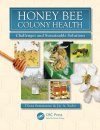About this book
Modern commercial beekeeping has changed from primarily honey production to crop pollination. With this change has come extraordinary stress-colonies are moved multiple times a year, increasing their exposure to diseases, parasites, and hive pests. Antibiotics and acaricides are being applied more frequently, resulting in resistance and comb contamination. The future use of bee colonies as mobile pollinator populations requires modern management methods with fresh perspectives on nutrition, breeding practices, and the role of microbes in sustaining colony health.
"Honey Bee Colony Health: Challenges and Sustainable Solutions" summarizes the current status of honey bees and possible reasons for their decline. This beautifully illustrated volume provides a foundation for management methods that maintain colony health. Integrating discussions of Colony Collapse Disorder, the chapters range from information on the new microsporidian Nosema ceranae pathogens, the current status of the parasitic bee mites, updates on bee viruses, and the effects of these problems on our important bee pollinators. This indispensable text also presents methods for diagnosing diseases and updated information on the current status of bee breeding.
Honey bee colonies are in greater demand and are renting for higher fees than ever before. Finding ways to prevent outbreaks of disease and to control parasites is essential for reducing colony losses. The accumulation of knowledge from a range of bee scientists, "Honey Bee Colony Health: Challenges and Sustainable Solutions" aims to inspire future generations of researchers, beekeepers, and students to continue to study bees and keep them healthy and pollinating.
Contents
- Honey Bee Health: The Potential Role of Microbes
- Microflora between the Seasons Especially Winter and Spring
- Breeding Resistance
- Bee Breeding Practices and Genetic Diversity in Domestic Honey Bees
- Global Status of Bee Mites
- Honey Bee Viruses and Their Effect on Bee and Colony Health
- PCR for the Analysis of Nosema in Honey Bees
- Nosema Ceranae Detection by Microscopy and Antibody Tests
- Chalkbrood Re-Examined
- Small Hive Beetle
- Cellular Response in Bee Organs/Tissues on Non-Pathogenic Effects (Pesticides)
- Fungicides in Pollen and Bee Bread from Almond Orchards
- Impact of Orcbard Fungicide Spraying on Lowering the Amount of Symbiotic Fungi in Bee Bread and Its Implications for Reduced Colony Resistance
- Bee Bread Mycoflora/Fungus Competition Conveying Natural Resistance
- Interactions Between Risk Factors in Honey Bees
- Understanding the Impact of Honey Bee Diseases on Crop Pollination
- Molecular Techniques for Honey Bee Diagnosis
Customer Reviews
Biography
Diana Sammataro, co-author of the "
Beekeeper's Handbook", began keeping bees in 1972 in Litchfield, Connecticut, setting up a package colony in her maternal grandfather's old bee hive equipment. From then on, she decided that her B.S. in Landscape Architecture (University of Michigan, Ann Arbor), would not be a career, but that honey bees would. After a year of independent studies on floral pollination (Michigan State University Bee Lab, East Lansing), she earned an M.S. in Urban Forestry (University of Michigan, Ann Arbor). In 1978 she joined the Peace Corps and taught beekeeping in the Philippines for 3 years. On returning, she worked at the USDA Bee Lab in Madison, Wisconsin, under Dr. Eric Erickson, studying the effects of plant breeding and flower attraction of bees in sunflower lines. When the lab closed, she eventually went to work at the A.I. Root Company as Bee Supply Sales Manager in Medina, Ohio.
In 1991, she was accepted at the Rothenbuhler Honey Bee Lab at The Ohio State University, Columbus, to study for a Ph.D. under Drs. Brian Smith and Glen Needham. In 1995, she worked as a post-doctoral assistant at the Ohio State University Agricultural Research Center in Wooster, Ohio, with Dr. James Tew and in 1998 at the Penn State University Bee lab. Early in 2002, she was invited to join the USDA-ARS Carl Hayden Honey Bee Research Center in Tucson, Arizona. Her current position is as a Research Entomologist and her work includes research on bee nutrition problems, how they influence Varroa, and current pollination problems.
Jay Yoder teaches courses in microbiology/immunology and general biology as professor of Biology at Wittenberg University.His research focuses on disease transmission by insects, ticks and mites of medical-veterinary importance, and biological control emphasizing pheromone-assisted techniques, entomopathogenic fungi, and water balance. This research has resulted in over 100 peer-reviewed publications in scientific journals with undergraduate students as co-authors. In addition, numerous of these undergraduate students have won research awards at regional and national scientific conferences. Jay holds a B.A. from the University of Evansville (Biology, Chemistry, French), a Ph.D. from The Ohio State University (Entomology; laboratory of Dr. David Denlinger) and conducted Post-doctoral work at Harvard University (laboratory of Dr. Andrew Spielman).









































